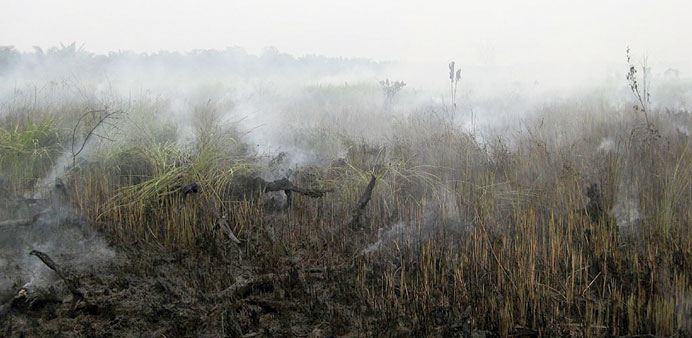Sadly, many of these fires were started deliberately. Every year fires are lit in order to clear land for plantation. This method of clearance is called ‘slash and burn’. It’s the easiest and quickest way to clear land, but it produces a vast amount of smoke. Although it’s illegal in Indonesia, its use is widespread.
This year the fires have been worse than usual. This is because Indonesia is currently in a drought and the lack of rain ensures that the vegetation is very dry and brittle, which is excellent fodder for fires. The country often experiences a drought during an El Niño event, and the current El Niño is one of the strongest on record.
El Niño is the slight warming of the surface waters of the Pacific Ocean. It’s a natural phenomenon which happens every five to seven years, but it can have a dramatic effect on the weather around the globe. One of the impacts that is often seen during an El Niño event, is a reduction in the rain around Southeast Asia. This year is no exception and, as predicted, Indonesia is currently in the grip of a severe drought.
The drought has allowed the fires to burn more ferociously than usual, and some of them have also become out of control. The burning of vegetation will always produce a substantial amount of smoke, but in Indonesia the problem is exacerbated because oddly the soil is flammable.
Most soils aren’t flammable. If you try to set fire to Qatar’s sandy earth, it won’t burn. However, the soil in Indonesia is peat, which is rather different. Peat consists of partly decomposed vegetable matter, which has formed a boggy mass after many thousands of years.
Peat is a very useful type of soil. On a global level, a healthy peat bog will absorb and store carbon, making it very valuable in the fight against climate change. At the same time, peat also works on a more local level to prevent flooding. It behaves as a giant sponge, absorbing rainwater which it then slowly releases over time, naturally controlling its distribution. This helps to regulate the amount of water running down a hillside, and will therefore reduce the impact of flooding further down the valley.
Peat is clearly very beneficial, unless, that is, it dries out. Without water it begins to release carbon dioxide and also takes on the unfortunate property of being flammable. In fact, not only can dry peat burn, but it can smolder underground for many weeks.
A peat fire is not necessarily visible on the surface. The fire can travel for long distances underground, before suddenly resurfacing many kilometers away from the original fire, without any warning whatsoever. As it travels under the surface, it can damage roots of trees and plants, destroying vegetation over a much larger area than was affected by the visible fire. If the fire is particularly severe, then sometimes the peat can be completely burnt away, exposing the bare rock underneath. This would leave the ground unable to support vegetation for decades to come.
Fortunately, peat is usually too wet to burn, so peat fires are fairly unusual. However, El Niño has ensured that Indonesia is currently in the grip of a drought, so a number of the fires that were started to clear vegetation have, in turn, set fire to the soil, and the peat has started to burn.
It is estimated that peat fires release about three times more smoke than a standard forest fire, and these fires have been burning for months .The smoke is so intense that it can be seen on satellite pictures. It’s affecting the air that tens of millions of people breathe and the fires show no sign of easing any time soon.
There was a similar problem with suffocating smoke in 1997-1998, and it is not a coincidence that this coincided with another El Niño event. In fact the 1997-1998 El Niño was the strongest on record. It triggered a crippling drought in much of Southeast Asia, which again lead to multiple wildfires. The resulting yellow haze affected an area over 3,000 kilometers in diameter for many months.
The conditions were so severe that they led to an agreement on transboundary pollution being approved by the Association of Southeast Asian Nations in 2002. Indonesia took until September 2014 to ratify the treaty, and were the last country to do so. However, the agreement seems to have had little effect and the fires have yet to be extinguished.
Source: Gulf Times | 15 November 2015














